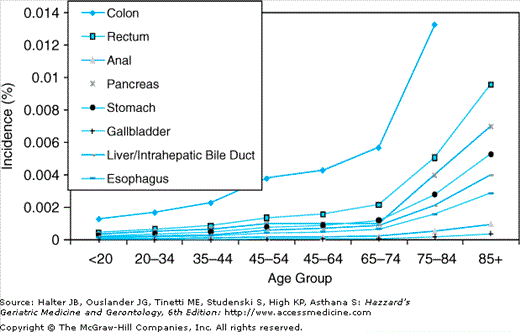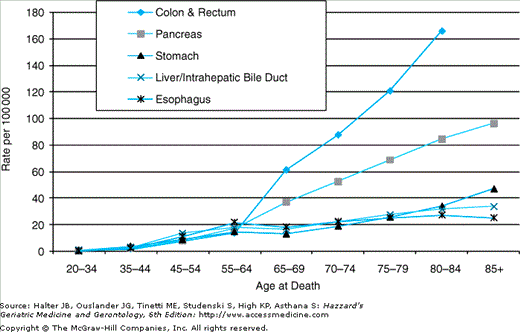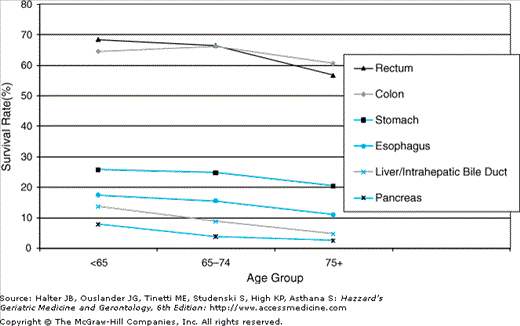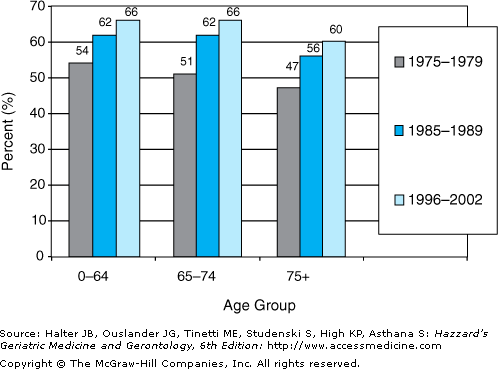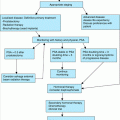Gastrointestinal Malignancies: Introduction
Gastrointestinal cancers are primarily diseases of persons in their sixth, seventh, and eighth decade of life. Both incidence and mortality of gastrointestinal cancers increase with advancing age (Figures 98-1 and 98-2). Many elderly persons, however, have additional medical problems that almost certainly contribute to this inferior outcome. This chapter will explore the epidemiology, presentation, treatment options, and disparities in the care of older persons with gastrointestinal malignancies.
In general, the symptoms and presentation of gastrointestinal cancers in older individuals appear similar to those of persons of younger age. Although treatments for these cancers have been developed primarily in younger patients, greater expertise over time has permitted similarly safe and efficacious therapy to be extended to older age groups. Since the greatest percentage of gastrointestinal cancers are located in the colon and rectum, most of the information regarding older persons focuses on colorectal cancer. Unfortunately, there is a paucity of information concerning the treatment of elderly patients with other gastrointestinal malignancies. In this chapter, gastrointestinal malignancies are ordered by incidence in the U.S. population.
Colorectal Cancer
Colorectal cancer accounts for approximately 10% of all new cancer cases and 10% of all cancer-related deaths in the United States. In fact, colorectal cancer causes more deaths than prostate cancer in men 60 to 79 years of age and more deaths than breast cancer in women 80 years or older. In 2008, 108,070 new cases of colon cancer and 40,740 new cases of rectal cancer will be diagnosed. The probability of developing colorectal cancer increases from 0.07% in the first four decades of life to 4.3% for females and to 4.8% for males in the seventh decade of life. Although the 5-year relative survival (66%) with this cancer is identical for persons younger than 65 and for persons 65 to 74 years, it declines to 60% for individuals 75 years or older (Figure 98-3 and Figure 98-4).
Six out of seven studies suggest that elderly patients present at the time of diagnosis with the same probabilities of having localized and advanced colon cancer as younger patients. In randomized studies, elderly patients are reported to have the same performance status and incidence of tumor-related symptoms as younger patients, but tend to have more disease-related weight loss. Older patients also appear to have a greater incidence of right-sided (proximal) tumors and higher rates of obstruction and perforation. This in turn results in a greater likelihood of acute presentations, leading to a higher perioperative mortality rate in this older age group.
While some investigators have noted that overall survival is shorter in elderly patients, this difference is not significant if noncancer deaths are excluded. In fact, comorbid illnesses account for a substantial number of deaths among older patients with colorectal cancer. In one study of 29,733 patients 67 years and older with localized colorectal cancer in the Surveillance, Epidemiology and End Results (SEER)/Medicare database, congestive heart failure, chronic obstructive pulmonary disease, and diabetes mellitus accounted for 9.4%, 5.3%, and 3.9% of deaths, respectively.
As in younger individuals, most older persons have no clearly defined risk factors for the development of their colorectal cancer. Hereditary syndromes, such as familial adenomatosis polyposis or hereditary nonpolyposis colorectal cancer, have less impact in this older age group, since the majority of cases are diagnosed before the age of 65 years. There is one risk factor specific to men who were curatively treated with radiation for localized prostate cancer. These men have a 70% increased risk of developing cancer in previously irradiated portions of the bowel and could potentially benefit from more frequent colorectal cancer screening.
Various dietary supplements and drugs have been proposed as chemopreventive agents for colorectal neoplasia. Of these, aspirin has been the most widely studied; the regular use of this drug appears to confer a significant risk reduction (relative risk 0.56–0.68).
In at least two prospective cohort studies, the use of postmenopausal estrogens has been shown to reduce the risk of colorectal cancer by approximately 30%. Estrogen supplementation, however, has been associated with an increased risk for coronary heart disease, breast cancer, thromboembolic events, and early mortality in at least one large randomized study of postmenopausal women, thereby limiting its use as a chemopreventive agent in older women.
Most recently, it has been reported that cholesterol-lowering “statins” can significantly reduce the risk of colorectal cancer. As compared to individuals who did not use statins, individuals who used these agents for at least 5 years were able to reduce their relative risk of colorectal cancer by one-half.
Approximately one in two persons will have an adenomatous polyp in their colon by the age of 70 years. The risk of sporadic colorectal cancer can be reduced by 50% to 90%, if adenomatous polyps are implicated by fecal occult blood testing or are visualized by barium enema, sigmoidoscopy, or colonoscopy and are then removed before they transform into a malignancy over a 5 to 10 year period. Three randomized trials have demonstrated that routine fecal occult blood testing can diminish colon cancer mortality by 15% to 20% during an 8 to 18 year follow-up period. The mortality benefit for older patients was slightly lower (10%–16%) than for younger patients (19%–23%).
Case–control studies suggest that lower endoscopy and removal of polyps may decrease the incidence and mortality of colorectal carcinoma by 50% to 80%. However, screening extends life to a lesser degree with advancing age. Although colonoscopy appears to be particularly beneficial in older patients who have a higher incidence of proximal neoplasms, which are beyond the view of a flexible sigmoidoscopy, the risk of perforation from colonoscopy is higher than from sigmoidoscopy (OR 1.8). This risk increases with advancing age and number of comorbidities. Therefore, screening decisions must be individualized for every elderly patient.
Since only a small percentage of persons at risk for colorectal neoplasia undergo routine screening in the United States, Medicare now provides reimbursement for surveillance fecal occult blood testing plus sigmoidoscopy or barium enema or colonoscopy for all beneficiaries. This has increased the prevalence of “screening within 1 year” for fecal occult blood testing from 20% in persons younger than 65 years to 26% in persons 65 years and older and the prevalence of “endoscopy within 5 years” from 37% in persons younger than 65 years to 48% in persons 65 years or older.
Most older persons have a stated preference to continue colorectal cancer screening, feeling that their own life expectancy does not factor into this decision. Since the risk of advanced neoplasia and colorectal cancer is highest in the oldest individuals, it seems doubtful that screening should be arbitrarily discontinued after a certain age. In the United States, an individual who reaches the age of 80 years has an average life expectancy of an additional 8.6 years for women and 6.7 years for men. At age 85 years, average survival is 6.7 years for women and 4.7 years for men. This estimate must be adjusted for the number and severity of chronic diseases affecting the individual, as well as his or her functional status. It may be reasonable to discontinue screening when life expectancy is shorter than the time a polyp progresses to a cancer, that is, 5 to 10 years.
Cancers of the colon are typically resected with a hemicolectomy. Whether older age is an adverse prognostic factor in resection of localized colon cancer is controversial. Data on 20,862 patients undergoing surgery in 1997 for colon cancer from the Nationwide Inpatient Sample, a claims-based database, suggest that perioperative mortality increases gradually with advancing age until the age of 80 years, after which a substantial increase in mortality is seen (6.9% for patients older than 80 years). In Australia, patients 70 years and older had a worse prognosis for early-stage colon cancer treated with surgery alone. A European study also showed increased 30-day morbidity and mortality rates for patients 80 years and older compared to their younger counterparts.
Older patients in the Nationwide Inpatient Sample from 1997 had lower mortality rates at high-volume hospitals than at low-volume institutions: 3.1% versus 4.5% for patients older than 65 years (p = 0.03). This effect was even more pronounced for patients older than 80 years, where 4.6% of patients died at high-volume centers compared to 7.3% at smaller institutions (p = 0.04). Therefore, it may be preferable to send the very oldest patients with colon cancer to high-volume hospitals for their resections.
A tendency to perform less aggressive surgery in older patients may be evident from a recent analysis of 116 995 adults with localized colorectal cancer in the SEER database (1988–2001). This retrospective study revealed that patients 71 years or older were half as likely to receive adequate lymph node evaluation (examination of at least 12 lymph nodes) as younger patients. Multiple studies have now demonstrated that inadequate lymph node evaluation correlates with inferior survival. These data would suggest that less aggressive surgical intervention predisposes elderly patients to a higher risk of recurrence and cancer-related death.
Increasingly, laparoscopy-assisted colectomies are being performed in the United States and elsewhere. Randomized studies indicate that patients undergoing this procedure have a similar outcome to patients undergoing an “open” colectomy, with slightly less postoperative pain and a one-day shorter hospital stay. Persons 75 years or older tolerate laparoscopic-assisted colectomy equally well as younger individuals. One study compared 51 patients 70 years or older who underwent laparoscopic colectomy to 102 age-matched patients who underwent open colectomy. Older patients had less overall morbidity with laparoscopic colectomy (17.6%) than with open surgery (37.3%), suggesting that laparoscopic surgery may lessen surgical morbidity for frail, elderly individuals (p = 0.01).
A radical resection with anastomosis or ostomy is the standard surgical procedure for cancers of the rectum. A Veteran’s Administration study of 7243 patients who underwent surgery for their rectal cancer during the period of 1990 to 2000 revealed that 30-day mortality following resection for rectal cancer was 2.1% for patients younger than 65 years compared with 4.9% for patients 65 years or older (p < 0.0001). Five-year survival was 60% versus 48%, respectively (p < 0.0001). French investigators reviewed the records of 92 surgical patients who were 80 years or older and matched these to records of 276 younger patients who underwent resection during the same time interval. Although not statistically significant, older patients had a higher operative mortality than younger patients (8% vs. 4%, respectively). Among elective surgeries, the operative mortality was nearly identical (3%–4%). Although 5-year overall survival was greater for younger patients, 5-year cancer-specific survival was comparable for the two groups.
Since the publication of a National Institutes of Health (NIH) consensus statement in 1990, 5-fluorouracil (5-FU)-based adjuvant therapy has represented the standard of care for patients in the United States following the complete resection of colon cancer that has spread to regional lymph nodes (stage III disease). A benefit for postoperative chemotherapy has not been prospectively demonstrated in patients with fully resected, muscle-invasive, lymph node-negative (stage II) colon cancer. However, stage II cancers with high-risk features for recurrence (e.g., presentation with obstruction, perforation, or invasion into adjacent organs—stage IIb) are often treated by medical oncologists and are included in many randomized adjuvant trials.
Older patients receive adjuvant chemotherapy less often than their younger counterparts. A retrospective cohort study, utilizing the SEER database, identified 6262 patients 65 years or older with resected stage III colon cancer from 1991 to 1996. Overall, 55% of patients received adjuvant chemotherapy within 3 months of colon cancer resection. The likelihood of receiving treatment declined steeply with increasing age (Table 98-1). Similar results were noted in an Italian study of 1014 patients with resected stage II/III colon cancer.
AGE | TOTAL NUMBER OF PATIENTS | PERCENTAGE OF PATIENTS TREATED | HOSPITALIZATIONS FOR CHEMOTHERAPY-RELATED TOXICITY | |
|---|---|---|---|---|
Stage III colon cancer Schrag 2001 | 65–69 | 1261 | 78% | 7% |
70–74 | 1552 | 74% | 8% | |
75–79 | 1492 | 58% | 9% | |
80–84 | 1100 | 34% | 12% | |
85–89 | 604 | 11% | 13% | |
Stage II/III rectal cancer Schrag 2001 | 65–69 | 367 | 60%* | |
70–74 | 392 | 52%* | ||
75–79 | 301 | 36%* | ||
80–84 | 231 | 23%* | ||
85+ | 120 | 12%* | ||
Stage IV colorectal cancer Sundararajan 1999 | 65–69 | 377 | 45% | |
70–74 | 411 | 41% | ||
75–79 | 366 | 27% | ||
80–84 | 262 | 18% | ||
85+ | 214 | 5% |
The reason for this age-related disparity in management is not entirely clear. In one study utilizing the California Cancer Registry, oncologists cited patient refusal, comorbid illness, or advanced age as the most common reasons for not providing chemotherapy to elderly patients with resected colon cancer. Financial considerations and logistical problems may also prevent some elderly from seeking care. Additionally, treatment for older patients is more frequently discontinued, suggesting reluctance by physicians to treat older patients who have experienced some degree of side effects to chemotherapy.
A pooled analysis of 3351 patients in the United States, stratified by decade of life, from seven randomized trials evaluated the benefit of adjuvant chemotherapy in elderly persons with stage II or III colon cancer. The primary conclusion of this pooled analysis was that elderly patients derive the same clinical benefit from postoperative chemotherapy as younger patients. Treatment-related toxicity was somewhat higher for older patients, yet not statistically significant. Another U.S. study, however, could not extend this observation to patients 75 years and older, given limitations in the data.
Adjuvant chemotherapy also appeared to be slightly more toxic for elderly patients in a SEER-derived retrospective cohort study (Table 98-2). Hospitalization for various chemotherapy-related toxicities increased steadily with advancing age. Prospective data from the Royal Marsden Hospital in London confirmed this trend toward higher rates of severe toxicity in patients 70 years or older.
SEVERE TOXICITY (NCI CTC GRADE ≥3) | AGE | P VALUE* | ||
|---|---|---|---|---|
<66 Yr | 66–70 Yr | >70 Yr | ||
Any | 46% | 53% | 53% | 0.01 |
Diarrhea | 16% | 23% | 21% | 0.01 |
Leukopenia | 14% | 18% | 17% | 0.23 |
Nausea/vomiting | 9% | 9% | 9% | 0.95 |
Stomatitis | 13% | 18% | 17% | 0.03 |
Infection | 2% | 5% |
||
